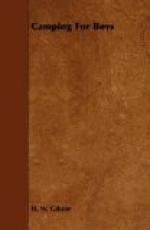In addition to the different styles of tents shown in the illustrations on page 43, the following description of how to make a ten-foot teepee is given by Charles R. Scott in his Vacation Diary:
Making a Teepee
Sew canvas together making oblong ABCD 20 by 10 feet; with E as centre and EA as a radius, draw half-circle AFD. From remaining canvas cut smoke flaps LKCM and ONBP. Sew piece of canvas at C and B making pocket for ends of smoke poles. Sew ml to hi and Po to GJ on one large piece of canvas. Sew lash to E to tie teepee to pole. Sew 6 or 7-foot lash to K and N to set smoke flaps with. Make holes in pairs from L to D and O to A for lacing pins. Ten poles 12 feet long are needed. Make tripod of nine of these and tie teepee at E to pole two feet from top and place over tripod.
In “Recreation,” April, 1911, in an article on “Tent Making Made Easy,” H. J. Holden tells how to make ten different tents with but one piece of canvas.
[Illustration: The Ten Foot Teepee]
Tent Wisdom
The best type of tent to use in a permanent camp is a wall tent, either 12 x 14 or 14 x 16, which will accommodate from four to six fellows. An eight ounce, mildew-proofed duck, with a ten or twelve ounce duck fly will give excellent wear. Have a door at each end of the tent and the door ties made of cotton cord instead of tape. Double pieces of canvas should be sewed in all the corners and places where there is unusual strain. Manilla rope is best for guys, and metal slides are preferable to wood. If the tents are made to order, have a cotton cord about two feet long sewed in each seam just under the eaves, so that one end shall hang down inside the tent and the other outside. The walls of the tent can then be rolled up and tied so that the tent will be thoroughly aired. Make sure that the end of the ridge pole and of the upright poles have iron bands to prevent splitting of the poles.
Bed on Ground
For a short-term camp, pine boughs make the best kind of a bed (see chapter on Tramps and Hikes for description of bed). Sometimes a rubber blanket is spread upon the ground and the boys roll themselves up in their blankets. An old camper gives the following suggestion to those who desire to sleep in this fashion:
The bed should be made in the afternoon while the sun is shining. To make the bed, clear the ground of twigs and stones. The space should be about 6 x 3 feet.
A “Hip Hole”
A shovelful of dirt is removed, making a shallow, transverse trench, about midway of the bed. This trench is the “hip hole” and the making of it properly is what renders the bed comfortable. In making the bed the following order should be observed:
(1) spread the rubber blanket;
(2) the blanket spread so that one-half only covers the prepared couch;
(3) then spread the woolen blankets so that the “hip hole” is in the right place;




